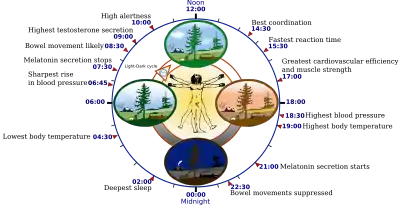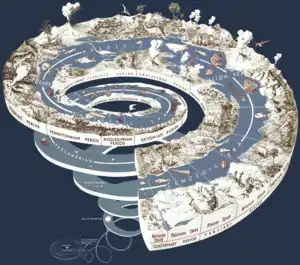Chronometry
Chronometry (from Greek χρόνος chronos, "time" and μέτρον metron, "measure") is the science of the measurement of time, or timekeeping.[1] And with the measurement, Chronometry employs the standardisation of time as well, serving as a significant reference for many and various fields of science.

The importance of the accurate and reliable measurement of time in addition to providing a standardized unit for chronometric experiments to the modern world and more specifically scientific research is immense. Despite the coincidental identicality of worldwide units of time, time produces a measure of change, and is a variable in many experiments, so time – and its standardization - is an essential part of many areas of science.
It should not to be confused with chronology, the science of locating events in time, which often relies upon it. Also, of similarity to Chronometry is Horology, the study of time, however it is commonly used specifically with reference to the mechanical instruments created to keep time, with examples such as stopwatches, clocks, and hourglasses. Chronometry is utilised in many areas, and its fields are often derived from aspects of other areas in science, for example geochronometry, combining geology and chronometry.
Early records of time keeping are thought to have originated in the paleolithic era, with etchings to mark the passing of moons in order to measure the year. And then progressed to written versions of calendars, before mechanisms and devices made to track time were invented. Today, the highest level of precision in timekeeping comes with atomic clocks, which are used for the international standard of the second.[2][3]
Etymology
Chronometry is derived from two root words, chronos and metron (χρόνος and μέτρον in Ancient Greek respectively), with rough meanings of “time” and “measure”.[4] The combination of the two is taken to mean time measuring.
In the Ancient Greek lexicon, meanings and translations differ depending on the source. Chronos, used in relation to time when in definite periods, and linked to dates in time, chronological accuracy, and sometimes in rare cases, refers to a delay.[5] The length of the time it refers ranges from seconds to seasons of the year to lifetimes, it can also concern periods of time wherein some specific event takes place, or persists, or is delayed.[4]

The root word is correlated with the god Chronos in Ancient Greek mythology, who embodied the image of time, originated from out of the primordial chaos. Known as the one who spins the Zodiac Wheel, further evidence of his connection to the progression of time.[6] However, Ancient Greek makes a distinction between two types of time, chronos, the static and continuing progress of present to future, time in a sequential and chronological sense. And Kairos, a concept based in a more abstract sense, representing the opportune moment for action or change to occur.
Kairos (καιρός) carries little emphasis on precise chronology, instead being used as a time specifically fit for something, or also a period of time characterised by some aspect of crisis, also relating to the endtime.[4] It can as well be seen in the light of an advantage, profit, or fruit of a thing,[5] but has also been represented in an apocalyptical feeling, and likewise shown as variable between misfortune and success, being likened to a body part vulnerable due to a gap in armor for Homer,[7] benefit or calamity depending on the perspective. It is also referenced in the Christian theology, being used as implication of God's action and judgement in circumstances.[8][9]
Because of the inherent relation between chronos and kairos, their function the Ancient Greek's portrayal and concept of time, understanding one means understanding the other in part. The implication of chronos, an indifferent disposition and eternal essence lies at the core of the science of chronometry, bias is avoided, and definite measurement is favoured.
Metron (μέτρον), is that by which anything is measured, a due, limit, or goal, also concerns a space that can be measured.[5] It can regard instruments for measuring, or even the result of measuring.[4]
Fields of Chronometry
Biochronometry
Biochronometry (also called chronobiology or biological chronometry) is the study of biological behaviours and patterns seen in animals with factors based in time. It can be categorised into circadian and circannual rhythms (circatidal and circalunar can be included in this categorisation depending on the relevance). Examples of these behaviours can be: the relation of daily and seasonal tidal cues to the activity of marine plants and animals,[10] the photosynthetic capacity and phototactic responsiveness in algae,[11] or metabolic temperature compensation in bacteria.[12]

Circadian rhythms of various species can be observed through their gross motor function throughout the course of a day. These patterns are more apparent with the day further categorised into activity and rest times. Investigation into a species is conducted through comparisons of free-running and entrained rhythms, where the former is attained from within the species’ natural environment and the latter from a subject that has been taught certain behaviours. Circannual rhythms are alike but pertain to patterns within the scale of a year, patterns like migration, moulting, reproduction, and body weight are common examples, research and investigation are achieved with similar methods to circadian patterns.[12]
Circadian and circannual rhythmicity can be seen in all organisms, in both single and multi-celled organisms.[13][14] A sub-branch of biochronometry is microbiochronometry (also chronomicrobiology or microbiological chronometry), and is the examination of behavioural sequences and cycles within micro-organisms. Adapting to circadian and circannual rhythms is an essential evolution for living organisms,[13][14] these studies, as well as educating on the adaptations of organisms also bring to light certain factors affecting many of species’ and organisms’ responses, and can also be applied to further understand the overall physiology, this can be for humans as well, examples include: factors of human performance, sleep, metabolism, and disease development, which are all connected to biochronometrical cycles.[14]
Mental Chronometry
Mental chronometry (also called cognitive chronometry) studies human information processing mechanisms, namely reaction time and perception. As well as a field of chronometry, it also forms a part of cognitive psychology and its contemporary human information processing approach.[15] Research comprises applications of the chronometric paradigms – many of which are related to classical reaction time paradigms from psychophysiology[16] – through measuring reaction times of subjects with varied methods, and contribute to studies in cognition and action.[17] Reaction time models and the process of expressing the temporostructural organisation of human processing mechanisms have an innate computational essence to them. It has been argued that because of this, conceptual frameworks of cognitive psychology cannot be integrated in their typical fashions.[18]
One common method is the use of event-related brain potentials (ERPs) in stimulus-response experiments. These are fluctuations of generated transient voltages in neural tissues that occur in response to a stimulus event either immediately before or after.[17] This testing emphasises the mental events’ time-course and nature and assists in determining the structural functions in human information processing.[19]
Geochronometry
The dating of geological materials makes up the field of geochronometry, and falls within areas of geochronology and stratigraphy, while differing itself from chronostratigraphy. The geochronometric scale is periodic, its units working in powers of 1000, and is based in units of duration, contrasting with the chronostratigraphic scale. The distinctions between the two scales have caused some confusion – even among academic communities.[20]
Geochronometry deals with calculating a precise date of rock sediments and other geological events, giving us an idea as to what the history of various areas is, for example, volcanic and magmatic movements and occurrences can be easily recognised, as well as marine deposits, which can be indicators for marine events and even global environmental changes.[21] This dating can be done in a number of ways. All dependable methods – barring the exceptions of thermoluminescence, radioluminescence[22] and ESR (electron spin resonance) dating – are based in radioactive decay, focusing on the degradation of the radioactive parent nuclide and the corresponding daughter product's growth.[21]

By measuring the daughter isotopes in a specific sample its age can be calculated. The preserved conformity of parent and daughter nuclides provides the basis for the radioactive dating of geochronometry, applying the Rutherford Soddy Law of Radioactivity, specifically using the concept of radioactive transformation in the growth of the daughter nuclide.[23]
Thermoluminescence is an extremely useful concept to apply, being used in a diverse amount of areas in science,[24] dating using thermoluminescence is a cheap and convenient method for geochronometry.[25] Thermoluminescence is the production of light from a heated insulator and semi-conductor, it is occasionally confused with incandescent light emissions of a material, a different process despite the many similarities. However, this only occurs if the material has had previous exposure to and absorption of energy from radiation. Importantly, the light emissions of thermoluminescence cannot be repeated.[24] The entire process, from the material's exposure to radiation would have to be repeated to generate another thermoluminescence emission. The age of a material can be determined by measuring the amount of light given off during the heating process, by means of a phototube, as the emission is proportional to the dose of radiation the material absorbed.[21]
History and Development
Early humans would have used their basic senses to perceive the time of day, and relied on their biological sense of time to discern the seasons in order to act accordingly. Their physiological and behavioural seasonal cycles mainly being influenced by a melatonin based photoperiod time measurement biological system – which measures the change in daylight within the annual cycle, giving a sense of the time in the year – and their circannual rhythms. Providing an anticipation of environmental events months beforehand to increase chances of survival.[26]
There is debate over when the earliest use of lunar calendars was, and over whether some findings constituted as a lunar calendar.[27][28] Most related findings and materials from the palaeolithic era are fashioned from bones and stone, with various markings from tools. These markings are thought to not have been the result of marks to represent the lunar cycles but non-notational and irregular engravings, a pattern of latter subsidiary marks that disregard the previous design is indicative of the markings being the use of motifs and ritual marking instead.[27]
However, as humans’ focus turned to farming the importance and reliance on understanding the rhythms and cycle of the seasons grew, and the unreliability of lunar phases became problematic. An early human accustomed to the phases of the moon would use them as a rule of thumb, and the potential for weather to interfere with reading the cycle further degraded the reliability.[27][29] The length of a moon is on average less than our current month, not acting as a dependable alternate, so as years progress the room of error between would grow until some other indicator would give indication.[29]

The Ancient Egyptian calendars were some of the first calendars made, and the civil calendar even endured for a long period afterwards, surviving past even its culture's collapse and through the early Christian era. It has been assumed to have been invented near 4231 B.C. by some, but accurate and exact dating is difficult in its era and the invention has been attributed to 3200 B.C., when the first historical king of Egypt, Menes, united the Two Lands.[29] It was originally based on cycles and phases of the moon, however, Egyptians later realised the calendar was flawed upon noticing the star Sothis rose before sunrise every 365 days, a year as we know it now, and was remade to consist of twelve months of thirty days, with five epagomenal days.[30][31] The former is referred to as the Ancient Egyptians’ lunar calendar, and the latter the civil calendar.
Early calendars often hold an element of their respective culture's traditions and values, for example, the five day intercalary month of the Ancient Egyptian's civil calendar representing the birthdays of the gods Horus, Isis, Set, Osiris and Nephthys.[29][31] The Mayans’ use of a zero date as well as the Tzolkin's connection to their thirteen layers of heaven (the product of it and all the human digits, twenty, making the 260 day year of the year) and the length of time between conception and birth in pregnancy.[32]
See also
| Look up chronometry in Wiktionary, the free dictionary. |
References
- Webster's Dictionary, 1913
- Lombardi, M.A.; Heavner, T.P.; Jefferts, S.R. (2007). "NIST Primary Frequency Standards and the Realization of the SI Second". NCSLI Measure. NCSL International. 2: 74–89.
- Ramsey, N.F. (2005). "History of Early Atomic Clocks". IOP Publishing. Cite journal requires
|journal=(help) - Bauer, W. (2001). A Greek-English Lexicon of the New Testament and Other Early Christian Literature (Third Edition). University of Chicago Press.
- Liddell, H & Scott, R. (1996). A Greek-English Lexicon. Oxford University Press, USA.
- Vrobel, S. (2007). The Kairos Syndrome. N.p.
- Murhchadha. F.O. (2013). The Time of Revolution: Kairos and Chronos in Heidegger. Bloomsbury Academic.
- Strong's Greek: 2540. καιρός (kairos). (n.d.). Retrieved October 2, 2020, from https://biblehub.com/greek/2540.htm
- Mark 1:15 Greek Text Analysis. (n.d.). Retrieved October 2, 2020, from https://biblehub.com/text/mark/1-15.htm
- Naylor, E. (2010). Chronobiology of Marine Organisms. Cambridge University Press.
- Bünning, E. (1964). The Physiological Clock: Endogenous diurnal rhythms and biological chronometry. Springer Verlag.
- Menaker, M (Ed.) (1971). Biochronometry: Proceedings of a Symposium. National Academy of Sciences, USA.
- Edmunds, L.N. (1985). Physiology of Circadian Rhythms in Micro-organisms. Elsevier.
- Gillette, M.U. (2013). Chronobiology: biological timing in health and disease. Academic Press.
- Abrams, R.A, Balota, D.A. (1991). Mental Chronometry: Beyond Reaction Time. Cambridge University Press.
- Jensen, A.R. (2006). Clocking the Mind: Mental chronometry and individual differences. Elsevier.
- Meyer, D.E, et al. (1988). Modern Mental Chronometry. Elsevier.
- Van der Molen, M.W, et al. (1991). Chronopsychophysiology: Mental chronometry augmented by psychophysiological time markers. John Wiley & Sons.
- Coles, M.G, et al. (1995). Mental Chronometry and the study of Human Information Processing. Oxford University Press.
- Harland, W.B. (1975). The two geological time scales. Nature.
- Elderfield, H (Ed.). (2006). The oceans and marine geochemistry. Elsevier.
- Erfurt, G (et al.). (2003). A fully automated multi-spectral radioluminescence reading system for geochronometry and dosimetry. Elsevier.
- Rasskazov, S.V, Brandt, S.R & Brandt I.S. (2010). Radiogenic isotopes in geological processes. Springer.
- McKeever, S.W.S. (1983). Thermoluminescence of solids. Academic Press.
- Price List – CHNet. (n.d.). Retrieved 25 October 2020, from http://chnet.infn.it/en/price-list/
- Lincoln, GA, Andersson, H & Loudon A. (2003). Clock genes in calendar cells as the basis for annual timekeeping in mammals. BioScientifica.
- Marshack, A. (1989). Current Anthropology: On Wishful Thinking and Lunar “Calendars”, Vol 30(4), p.491-500. University of Chicago Press.
- D’Errico, F. (1989). Current Anthropology: Palaeolithic Lunar Calendars: A Case of Wishful Thinking?. Vol 30(1), p.117-118. University of Chicago Press.
- Winlock, H.E. (1940). Proceedings of the American Philosophical Society: The Origin of the Ancient Egyptian Calendar, Vol 83, p.447-464. American Philosophical Society.
- Jones, A. (1997). On the Reconstructed Macedonian and Egyptian Lunar Calendars. Dr. Rudolf Habelt GmbH.
- Spalinger, A. (1995). Journal of Near Eastern Studies: Some Remarks on the Epagomenal Days in Ancient Egypt, Vol 54(1), p.33-47. Chicago University Press.
- Kinsella, J., & Bradley, A. (1934). The Mathematics Teacher: The Mayan Calendar. Vol 27(7), p.340-343. National Council of Teachers of Mathematics.

